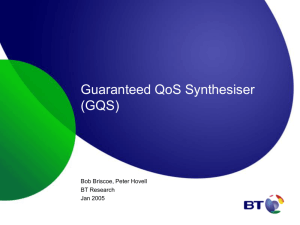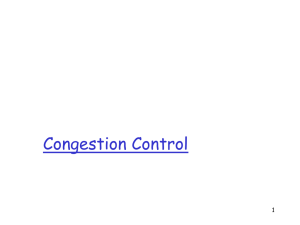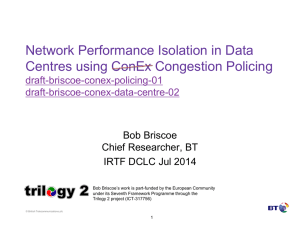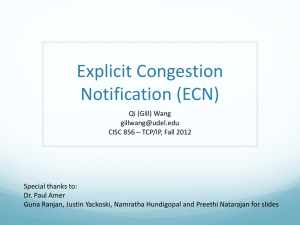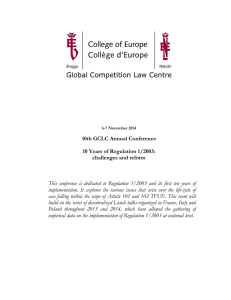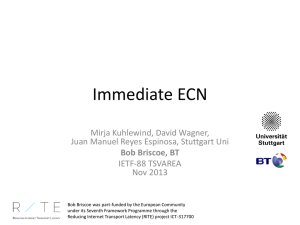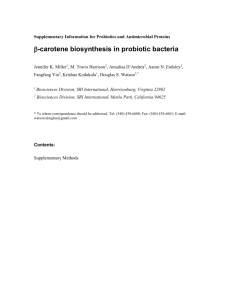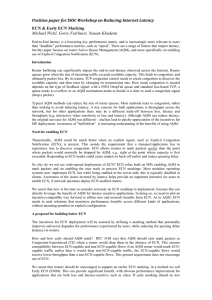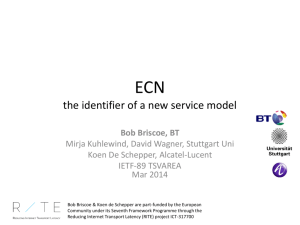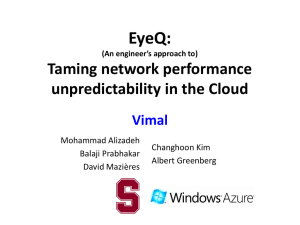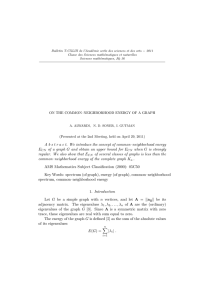ppt - Bob Briscoe
advertisement
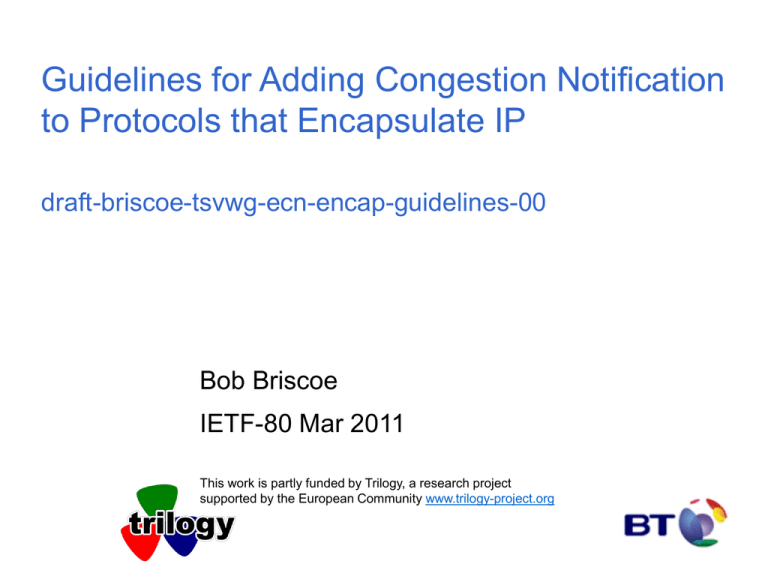
Guidelines for Adding Congestion Notification to Protocols that Encapsulate IP draft-briscoe-tsvwg-ecn-encap-guidelines-00 Bob Briscoe IETF-80 Mar 2011 This work is partly funded by Trilogy, a research project supported by the European Community www.trilogy-project.org explicit congestion indications from lower layers problem: standardise interface with IP • switches can ‘mark’ Ethernet header • using AQM1 developed for IP or MPLS • ‘mark’ may change CoS2 or a spare bit • but no Ethernet standard for this • L2 congestion notification stds exist • typically limited to subnet • pressure to link these subnets • using IP as portability layer = active queueneed management (e.g. RED) • AQM lower layers guidelines RED = random early detection 3 in CoS•= class of service into IEEE 802.1p to interface ECN ECN = explicit congestion notification 2 IP [RFC3168] positioning within canonical congestion control architecture 4 5 3 2 1 app L4 IP L2 1) congestion indication in focus lower layer 2) propagate up to ECN in IP 3) ECN in IP 4) feedback in e2e transport 5) response to congestion involves messing with variety of possible arrangements the neck of the hourglass app L4 IP L2 4 5 3 2 1 1 IEEE 802.1Qau (QCN) ATM ITU-T-I.371 Frame Relay • avoid precluding L2 innovation 4 5 • must not be over-prescriptive 1 4 5 • wide review necessary 3 2 1 3 app L4 IP L2 4 1 app L4 IP L2 status of congestion notification in protocols that encapsulate IP • IETF done: MPLS-in-MPLS, IP-in-MPLS [RFC5129], IP-in-IP [RFC6040] to do: trill-rbridge-options (in progress), & pass ECN thru tunnel protocols, eg. L2TP, GRE • Other standards bodies: done: QCN [802.1Qau], Frame Relay, ATM [I.371] (all subnet-local) todo: IEEE 802.1, (802.3, 802.11), …? & pass ECN thru tunnel protocols, eg. 3GPP GTP L2TP = layer 2 tunnelling protocol [RFC2661] GRE = generic routing encapsulation [RFC1701, RFC2784] QCN = quantised congestion notification GTP = GPRS tunnelling protocol [3GPP TS 29.060] 4 the main problem: incremental • IP-ECN designed for incremental deployment deployment congested queue supports ECN? transport supports ECN? IP header N Y N Not-ECT drop drop Y ECT drop CE • if transport only understands drop • lower layer must not send it congestion indications • need not mimic IP mechanism (grey) • but needs to achieve same outcome (white) ECT = ECN-capable transport CE = Congestion Experienced 5 guidelines • identifying whether transport will understand ECN • propagating ECN on encapsulation • propagating ECN on decapsulation • reframing issues 6 guidelines • identifying whether transport will understand ECN • new problem: will decapsulator understand ECN? • propagating ECN on encapsulation • copying ECN down for monitoring purposes • propagating ECN on decapsulation • combining inner & outer • reframing issues • marked bytes in marked bytes out • timeliness – don’t hold back any remainder 7 next steps • process • adopt as wg item? • will require liaison with other standards bodies • informational or best current practice? • document • add architecture diagram(s) • want to avoid precluding L2 innovation – need help • it just mentions that L3 switches mark IP-ECN – doesn’t say whether good or bad – I’d like to say it’s OK: any objections? 8 • to address: tunnelling protocols if never outer on the wire Guidelines for Adding Congestion Notification to Protocols that Encapsulate IP draft-briscoe-tsvwg-ecn-encap-guidelines-00 Q&A

